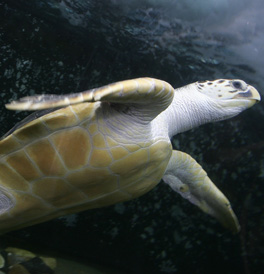Turtles lured to UK by jellyfish feast
Endangered leatherback turtles are arriving in British waters to feed on a rising number of jellyfish as Science Correspondent Tom Clarke reports.
The Marine Conservation Society says the huge number of jellyfish are luring the turtle population from their nesting grounds in the Caribbean to UK waters.
Leatherback turtles, with their distinct ridged shell, are the largest of all sea turtles. They can grow up to 3 metres long and weigh almost one tonne.
Surprise increase
Dwindling numbers in recent years have seen the species face extinction in the Pacific and Indian Oceans, but there has been a surprise increase in numbers in the northern hemisphere, particularly the Irish Sea.
Turtle specialist Dr Peter Richardson said it was not clear why leatherback numbers were on the rise across the Atlantic ocean.
“While conservation action at important nesting beaches is likely to be playing a part, it may also be due to the increasing availability of their jellyfish prey, combined with collapses in the populations of predatory fish such as tuna and sharks,” he said.
The vast blooms of jellyfish have been linked to warmer seas and and overfishing, which has reduced their natural predators.

Monitoring movements
August is the peak time to see leatherback turtles in UK waters, as they arrive from their nesting grounds in the Caribbean.
Unlike other reptiles, they are able to maintain a higher body temperature using metabolically generated heat.
We want to know if there are any hotspots so we know where they are and run protective measures. Dr Peter Richardson
There have been at least a dozen sightings in South West Wales and England this Summer.
But conservation groups are urging beach-goers to report sightings of leatherbacks to ensure their survival in future years.
“We want to know where and when they occur and if there are any hotspots so we know where they are and can run any protective measures where they occur,” Dr Richardson said.
Leatherbacks have the widest global distribution of all reptile species. They can be found as far north as Canada and Norway and as far south as New Zealand and South America.